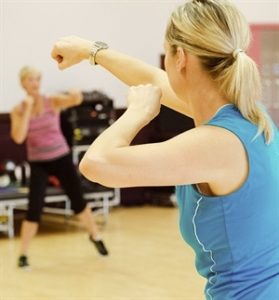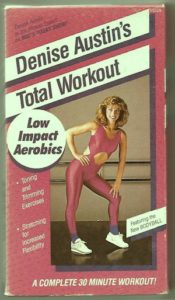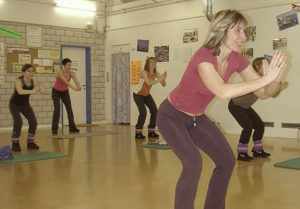Online Exercise Class Effectiveness
Many clubs and facilities are offering online classes for their members and the community. Are they effective?

Before we make a conclusion, let’s look at the physiological facts and research. Until a few years ago, video/online classes were not researched. However, there have been enough studies in the last few years to shed light on this question. The research really points to the kinesiological and physiological conclusions we would suppose and project from the study of human movements. And, some of these conclusions we can postulate from research on in-person exercise classes.
Video/online programs appear to have relatively good effectiveness in the application of simple movements with limited variations. For example, they are useful if you have had a shoulder injury, and the PT gives you four to five exercises to master for your home routine. In this case, it is only a select number of exercises, and the routine is slow-paced and well explained. In the case of more complex classes/programs, there is a psychological benefit to following an unfamiliar routine in coordination, overall mood, and the feeling of being in a group.

In energy system training, whether the goals are general endurance or interval training, on-demand classes may not be as effective as going to your facility. Yes, they are far better than nothing. However, if you were taking a 50-minute class, then expecting a 30-minute class to do the same thing is unreasonable. The critical question is that class a good workout for 30 minutes?
Remember, energy burned or kcal used is based upon lateral travel, vertical distance, and speed of movement. The few research studies on this found that most people don’t travel the same distance in either dimension as the instructor. Even if you go at a speed of 45 lateral shuffles per minute, you are likely not going as far or as high. Part of that is you probably don’t have the same room at home. The carpeted surface actually decreases your lateral movement distance due to ground reaction forces and your adaptation. The bottom line is you are keeping up with the instructor, but the kcal burn is less than you would expend at the gym. If your BMI or body composition is higher than average, you will likely subtract distance and decrease the speed of movement as well.

Many exercisers use heart rate to gauge intensity. With familiar, total body activity like walking, cycling, or stair climbing, this is likely an accurate means of knowing your intensity. As many of these on-demand classes use light weights or bands, which puts an accuracy wrinkle in the use of heart rate. Back in the day of low impact aerobics, it was widely postulated that adding light hand weights would increase aerobic intensity without increasing joint impact.
What the research symposium presented about this at ACSM noted was that the hand weights increased heart rate, yet not actual VO2 or energy expenditure. The reason was simply upper-body work disproportionately increases heart rate with almost no increase in energy expenditure. This is partially due to just gripping the weight and reducing blood flow. Low-impact aerobics trended like the dinosaur after that information was released. And, recent evidence points to the fact that if you have an injury, like a low back or knee issue, you are very likely to slow down the exercise intensity.
Resistance or strength workouts have even more evidence on effectiveness keys. The first consideration is that compared to resistance machines or free weights, you don’t have the same resistance options at home. Many people have a few dumbbells and one kettlebell, and rarely are they a maximum resistance they can perform for just 10-12 repetitions.
From an overload perspective, you just can’t do a lot more repetitions with a two-pound weight and expect it to be the same as fewer repetitions with a 20-pound weight. Remember, muscular gains are about overload. When you get to 10 repetitions, you have to stop. At home, resistance bands may be a better alternative to just one or two dumbbells because you can easily add resistance to get to that number of maximum repetitions. With most people exercising and moving less, a prime concern is maintaining muscular mass to support metabolism. Intensity or load is a critical factor in keeping your muscles.
One of the more interesting claims from these classes is you will get everything you need in a total-body, total dimension workout of just 30 minutes. Like the one set to failure idea, most people cannot work at the intensity to make this happen. Another factor is research points to the fact that for optimum gains, you really have to focus on one component during a workout. A plus is these all in one programs will probably maintain minimum to moderate fitness levels if the individual can work at an appropriate intensity. If you can make the effort higher than what you would perform at the facility, then you will likely get a minor increase in aerobic or strength fitness. Your VO2 max will go up a bit. However, there is a pain/discomfort factor in that adaptation.

The fitness bottom line? These programs are better than nothing, yet not as good as a class at your facility or doing regular resistance training. There is virtually no physiological way you are going to cram a 55-minute workout into 30 minutes, at least safely. On a budget or with limited space, they do provide a starter activity option. However, having home equipment such as a treadmill or upright bike is likely a better aerobic option. An extensive DB set or weight machine system will just give better results for strength until you can get back to the gym.
References
Boyer BT. (1990) A comparison of the effects of three strength training programs on women. Journal of Applied Sport Science Research 4(3):88-94.
Burgomaster KA, Howarth KR, Phillips SM, Rakobowchuk M, Macdonald MJ, McGee SL, and Gibala MJ. (2008) Similar metabolic adaptations during exercise after low volume sprint interval and traditional endurance training in humans. Journal of Physiology, 586(1), 151-160.
Drenowatz C, Grieve GL, DeMello MM. (2015) Change in energy expenditure and physical activity in response to aerobic and resistance exercise programs. Springerplus;4(1):798.
Esfandiari S, Sasson Z, Goodman J. (2014) Short-term high-intensity interval and continuous moderate-intensity training improve maximal aerobic power and diastolic filling during exercise. EuropeanJournal of Applied Physiology;114(2): 331-343.
Gillen JB, Gibala MJ. (2013) Is high-intensity interval training a time-efficient exercise strategy to improve health and fitness? Applied Physiology, Nutrition and Metabolism;39(3): 409-412.
Gordon R, Bloxham S. (2016) A Systematic Review of the Effects of Exercise and Physical Activity on Non-Specific Chronic Low Back Pain. Healthcare (Basel);4(2):22.
Graupensperger S, Gottschall JS, Benson AJ, Eys, M, Hastings B, and Evans MB. (2019) Perceptions of groupness during fitness classes positively predict recalled perceptions of exertion, enjoyment, and affective valence: An intensive longitudinal investigation. Sport, Exercise, and Performance Psychology;8(3), 290–304.
Kraemer WJ, Ratamess NA. (2004) Fundamentals of resistance training: progression and exercise prescription. Med Sci Sports Exerc;36(4):674–88.
Lowe AL, Lloyd LK, Miller BK, McCurdy KW, Pope ML. (2010) Accuracy of polar F6 in estimating the energy cost of aerobic dance bench stepping in college-age females. J Sports Med Phys Fitness;50(4):385–394.
Mann T, Lamberts RP, Lambert MI. (2013) Methods of prescribing relative exercise intensity: physiological and practical considerations. Sports Med;43(7):613–625.
Pollock ML, Gaesser GA, Butcher JD, Despres JP, Dishman RK, Franklin BA, Garber CE. (1998) ACSM position stand: the recommended quantity and quality of exercise for developing and maintaining cardiorespiratory and muscular fitness, and flexibility in healthy adults. Medicine and Science in Sports and Exercise;(30): 975-991.
Schoenfeld BJ. (2010) The mechanisms of muscle hypertrophy and their application to resistance training. J Strength Cond Res;24(10):2857–2872.
Schmidt D, Anderson K, Graff M, Strutz V. (2016) The effect of high-intensity circuit training on physical fitness. J Sports Med Phys Fitness;56(5):534–540.
Yáñez-Sepúlveda R, Barraza-Gómez F, Báez-San Martin E, et al. (2018) Differences in energy expenditure, amount of physical activity and physical exertion level during a Zumba fitness class among adult women who are normal weight, overweight and obese. J Sports Med Phys Fitness;58(1-2):113–119.

